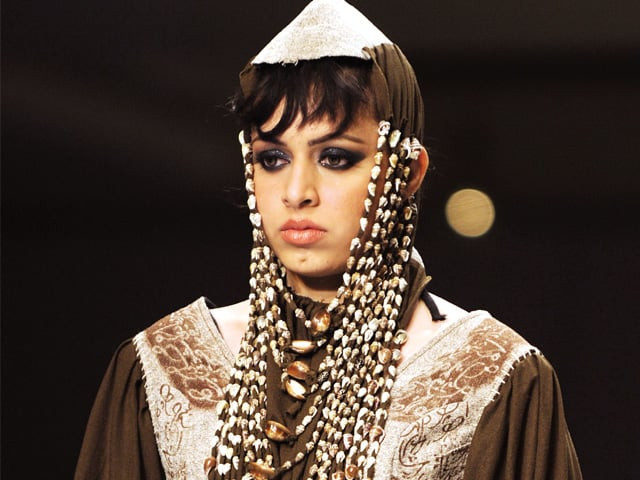The fashion week that was
Taking a closer look at the daily events of the capital's first fashion week.

With a sluggish three and a half hours delay in the proceedings, one didn’t expect to be enthralled by what the event had in store, but was pleasantly surprised as Gujranwala stepped into the game.
Graduate shows by fashion schools are always parcelled high in creativity and the Gujranwala Institute of Fashion and Technology (GIFT) was no exception. Zainab Omar from Blue Chip was spellbound by the young students’ work, “This is how we will combat fundamentalism,” she enthused. “Give people a chance to express themselves, show their creativity and do something productive and meaningful.”
Some of the pieces depicted were bold and admirable for their artistic interpretation but it wasn’t just the clothes that made an impact. Even the accessories, particularly the bags caught the audience’s attention for their innovative take on ordinary elements.
A young designer trained in Dubai, Bisma, followed up with a line of simple and graceful ensembles in chantilly lace predominately in gold with kamdani and conventional embellishment. Bisma’s collection showcased what the Pakistani woman has been wearing and provided a good insight to foreign onlookers of what’s en vogue for the average woman. Her finale piece was a skilfully crafted gown made entirely from tissue! With a large rose in the centre of the gown, the garment was an ingenious way to draw attention to her sponsor Rose Petal Tissues that also made an important social comment on fashion going green.
For centuries Lawrencepur has been the back bone for men’s store and the collection they showcased in a range of suits, pants, blazers and shirts for the corporate man were just as impeccably done.
The Islamabad Fashion Week based its premise on showcasing mass retail brands and had Metro Shoes providing footwear for the shows.
The inclusion of a mass show brand with an extended history in retail was a commendable move. Although the attempt at pulling a Loboutin with magenta and scarlet soles drew disdain from fashionistas in the front row, it was heartening to see a local manufacturer experimenting and taking inspiration from Fendi and other global brands.
The night closed with a high dose of dramatic traditionalism with Rehana Saigol’s Jashn collection that celebrated the sub continental bride. The designer specialises in recreating the romance of the old world, and with her husband, Shakil’s input in the men’s line, she managed to peak into traditional male fashion that can easily work in contemporary times. While Shakil surrendering slightly to his wife’s love for glamour, he held his fort as his signature crisp white cotton jodhpur pants were paired with elegantly structured sherwanis.
The whole presentation tied beautifully together with Rehana’s glamour and Shakil’s sedate sophistication to represent Pakistan at its festive best.
Day 03
Islamabad Fashion Week picked up with unparallel ferocity on day three. Commencing three and a half hours late yet again, this time around the event ensured that the wait was well worth it with an impressive presentation by Iqra University and Bareeze’s Chinyere. The evening show belonged to Kamiar Rokni, and it came as no surprise that his showcase was, as always, spectacular. The seasoned Imran Kureishi swept his magic wand over the ramp and stunned audiences with the sudden transformation from a slap dash catwalk to absolute synchrony.
Shaiyanne Malik made a pristine opening but despite all her years in the industry, her collection is still abound with hits and misses - and more misses with a jarring and discordant design aesthetic and colour scheme. Malik is a designer who hasn’t yet learnt where to draw the line and needs to curb herself and edit her work Nonetheless, the choreography ensured for a pleasant fashion experience as comments amongst ladies fluctuated drastically from ‘wow’ to ‘disastrous’.
It was Iqra University’s first showing since its initiation last year, but the students earned the most glowing praise that they could have ever elicited from Charlet Duboc, a journalist at Vice Style in London who enthused, “I have done fittings at St Martins (the prestigious fashion design school in Central London) but am extremely impressed with the level of creativity that the students here have. In London students have no clue about what inspires them.” With abstract inspirations from butterflies to futuristic designs to an interpretation of Lady Gaga, this show was a real treat from its ensembles to the styling to the choreography.
From Iqra’s showing each segment came on stronger visually and creatively; Chinyere’s Rang Ja Pakistan showcase was a stunner in the true fashion sense. Drenched in desi funk and varied hues, this supremely wearable artsy desi collection was replete with delicious bags and beautiful jewellery. This is a Pakistan you want to wear, flaunt and pass on to your kids. “We will be starting shoes soon,” promises Zain Aziz of Chinyere upping the ante of desi cool pret in the country and firmly establishing the fact that mass market doesn’t mean cheap and gauche.
Kamiar Rokni closed the show with a repertoire of his brand showcasing his recent Folkistan and bridal wear collection. This time around he made additions to the line with kurtas for men that were cheeky and cool, akin to Rokni’s own personality. The hoodie sporting soda bottles attached to a kurta and a rooster embroidered at the back of another made quite a stir. What wowed audiences however was his marrying of bright colours like fushia, yellow and black on a wedding ensemble that showcased that Rokni is a designer par excellence whose creativity can shine through even in something as trite as a lenga. Needless to say many a young bride who isn’t afraid to make a statement will be queuing up this wedding season for Rokni’s exquisitely crafted trousseau.
Day 04
The finale didn’t quite make the bang that one hopes from a true finale show. Niolfer Shahid showcased what her brand Meeras does best: sophisticated regalia that made an awe inspiring impact with her meticulous embellishment and art prints, but lacked that energy and aplomb that one expects from finale shows. Nonetheless the hall was splitting at its seams with people shoving, pushing and trampling upon each other to get there for Shahid’s show.
The FnkAsia and Sanam Agha shows had near full attendance and were fun and brimming with energy with both brands creating uniquely desi ensembles. “I’ve taken influence from everywhere,” said Huma Adnan of FnkAsia, whose brand show cased a line of desi cool dresses and a variety of lowers that will do well with school and college girls and those hitting the beaches abroad. Adnan experimented heavily with lowers and created a range of churidaars and tights with indigenous yet innovative edgings like smocking, chundri and tie and dye. She also brought back the shalwar and did a variety of harem pants. “I did an Omani shalwar this time; this season I am just doing tiers,” said Adnan. “My Boho shalwars are a hot seller in Indian and all of this collection has been sold to India, Houston and California.” While the designer’s bags did not make as much of an impact, one piece, a turban turned into a satchel was inventive. All her jewellery was made from recycled pieces of scraps and left over fabric from her factory.
Sanam Agha seems to have gotten her groove back and with her luxury pret line in Islamabad, one could see that Agha had made a concerted effort of showcasing a collection that did justice to her fashion degree and her own stylish self. Each outfit had her signature dragonfly broche and the collection was predominantly based on the dexterous use of soosi to create a line of what she calls “indigenous romance” with the rose, the international symbol of love, as its central focus. “I love soosi, so I wanted to use it creatively in a manner that would appeal to everyone.” Agha’s opening piece, a very Missoni-esque black jump suit with fitted pants akin to a churidaar with layers at the ankle and a soosi upper, caught attention for its interesting fusion of a very eastern fabric crafted in a very western aesthetic. The collection further carried soosi as pants, belts and accents on ensembles. A watermelon pink jumpsuit also stood out for its structure as did a line of cut work dresses and tops. This is a line that had women pointing in excitement for future purchases.
The Islamabad Fashion Week came to a close dramatically with the announcement of a Pakistan chapter at the World Fashion Organisation and if there’s one thing that this week long fashion showcase established was strong international relations. Giving the opening to Sharifah Kirana, a Malaysian designer on day four was an excellent diplomatic move. Kirana showcased a line of traditional Malaysian women’s wear of a sarong and jacket and accorded an important window into Malay culture. There may not be a market for such clothing in Pakistan, but by inviting such designers, the country can strengthen its relations with its ‘friends’ and establish crucial social and cultural linkages.
Press conference
At the closing of the Islamabad Fashion Week, a press conference was held to announce that a Pakistan Chapter has been set up for the World Fashion Organisation (WFO).
“There should be no feudalism in fashion,” stated Arshad Siddiqui, the CEO of Triple E events. Yet despite his claims at a more democratised participation in fashion, Siddiqui is the CEO for life and the Excutive Director (Tariq Amin) shall complete a three year term and will be replaced only if the work is not up to the mark. WFO has been established to, “Increase participation in world fashion and to integrate Pakistan on the world fashion arena,” said Paco de Jaimes, the founder of WFO, who saw Pakistan’s inclusion the organisation as an effort at “building global bridges of understanding across nations”. The purpose of the WFO is to eradicate poverty and use fashion as a tool for development and peace since, “It is the largest source of industrial development, affecting billions around the world,” stated De Jaimes. It was established that the Pakistan Fashion Council, with Siddiqui along with a list of international and local fashion designers and Amin will collectively decide on that lucky individual who gets to participate at the World Fashion Week due to be held in New York in 2012.
The council will be hosting the Karachi Fashion Week in June and hopes to ignite international interest like it has at the onset of its debut fashion week in Islamabad.
Published in The Express Tribune, February 1st, 2011.


















COMMENTS
Comments are moderated and generally will be posted if they are on-topic and not abusive.
For more information, please see our Comments FAQ